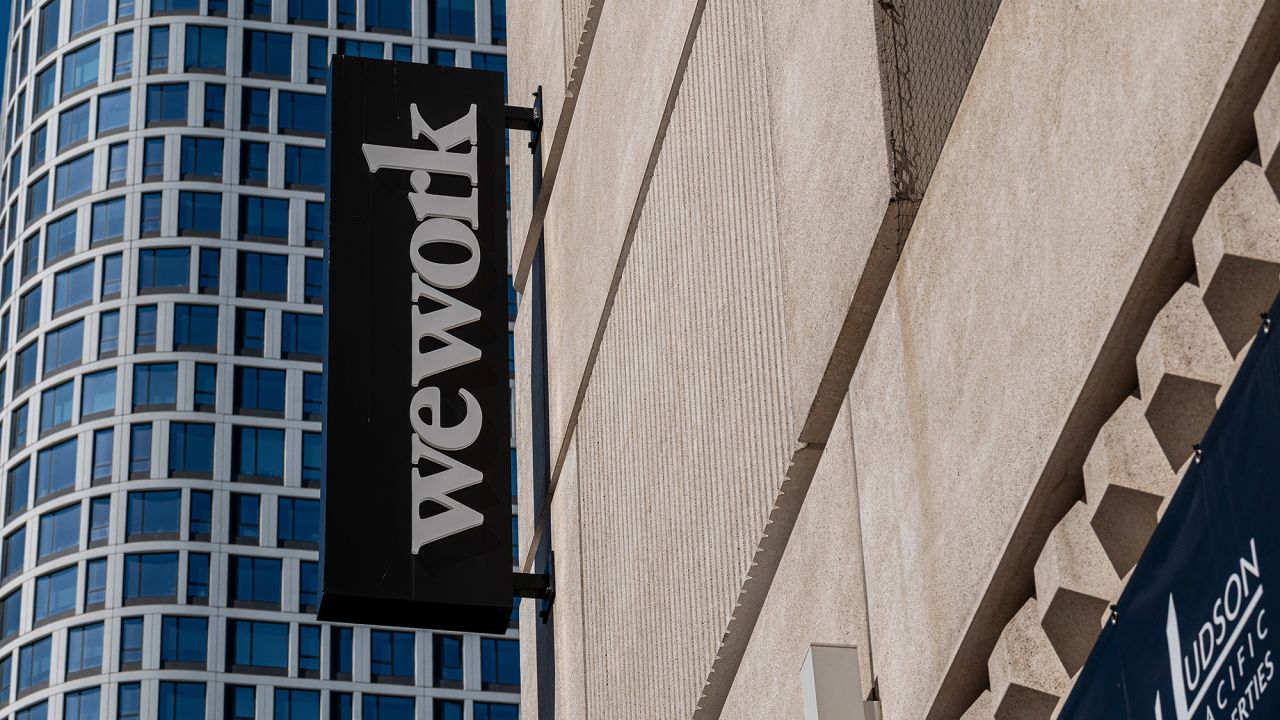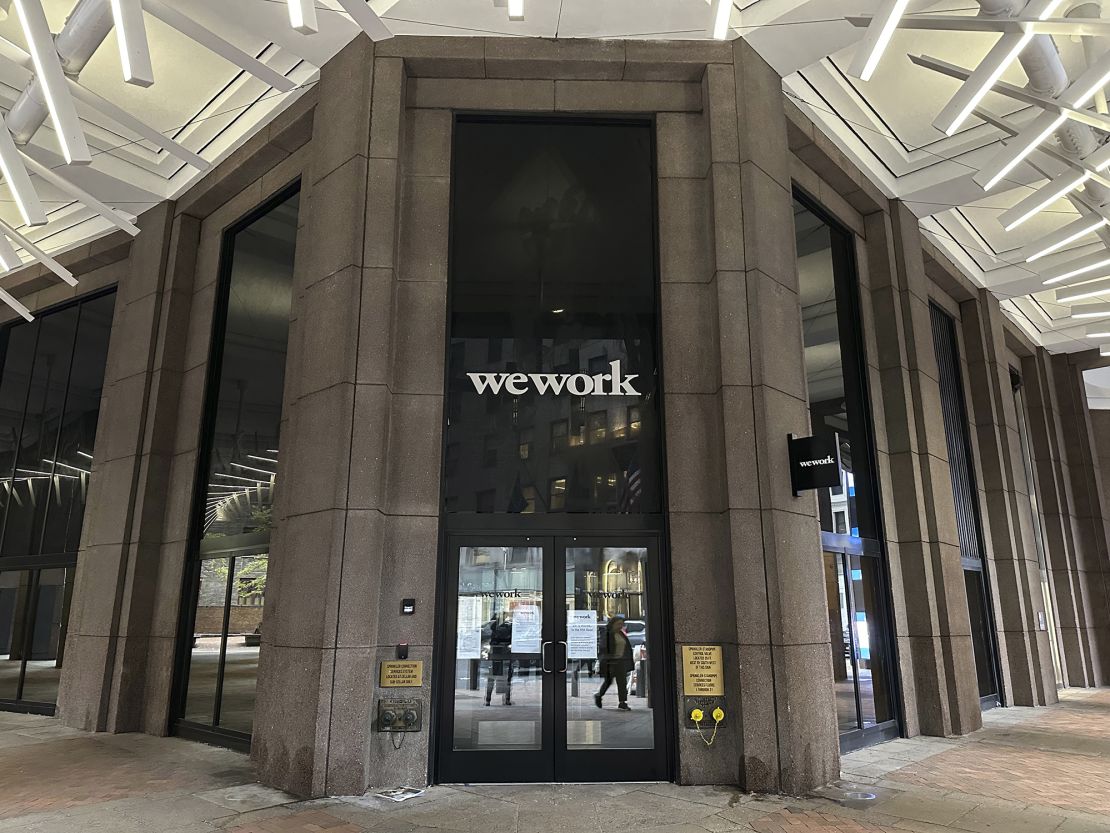
How WeWork’s bankruptcy could have a painful effect on cities
By Nathaniel Meyersohn, CNN
Updated 1:32 PM EST, Tue November 7, 2023

A WeWork co-working office space in San Francisco. WeWork filed for bankruptcy Monday.David Paul Morris/Bloomberg/Getty Images
New YorkCNN —
America has a glut of empty offices.
Now, some offices face losing WeWork, which has more than 600 locations in major cities.
WeWork filed for Chapter 11 bankruptcy Monday, throwing the future of the real estate company up in the air. WeWork said it would terminate some of its US leases.
WeWork’s bankruptcy will increase financial stress on commercial landlords that have rented large chunks of their office buildings to the co-working company.
Office landlords for years rushed to rent out space to WeWork, viewing flexible office spaces as the future of office life. But these bets have soured, and some property owners have taken on debt to stay afloat. About $270 billion in commercial real estate loans held by banks will come due in 2023, according to Trepp, a commercial real estate data provider.

Co-working spaces are getting weird
The loss of WeWork will increase vacancies, might lower rent for tenants, meaning less cash for some landlords already struggling to make debt payments in a high interest rate environment, commercial real estate experts say. In the worst case scenario, it may prompt landlord defaults on loans or mortgages, which could more broadly affect the banking system and hit city tax revenues even further
“Office properties – already facing financing hardships and [lower] values – now face a potential new wave of unexpected vacancies,” Moody’s economist Ermengarde Jabir said in a report Tuesday.
The bankruptcy could have a ripple effect on smaller and mid-sized banks holding landlords’ debt, causing banks to tighten loans to home and business owners, and stoking investor anxiety about the health of the financial system. The collapse of Silicon Valley Bank and Signature Bank earlier this year sparked fears about banks’ exposure to hard-hit commercial real estate. Goldman Sachs estimates that 55% of US office loans sit on bank balance sheets.
It could also hurt municipal governments that rely on commercial property taxes to provide services, potentially leading to budget cuts. In New York City, for example, office properties make up 21% of tax revenue.
“WeWork’s bankruptcy is a major shock to the office market, especially because the market was in deep trouble,” said Stijn Van Nieuwerburgh, a real estate professor at Columbia Business School. “This is another huge problem for the office market to contend with.”
No single tenant can make or break the office market, he said. But “as much as any one tenant can matter, WeWork would be it.”
Cities hit hardest
Offices in New York City, San Francisco and Boston will be hit hardest by WeWork’s bankruptcy, experts say.
Around 42% of WeWork’s occupancies are in those three cities, according to CoStar, a commercial real estate data firm. WeWork already has plans to close 1.9 million square feet in these three markets, about 35% of its footprint.
In New York City, where WeWork was once the largest corporate office tenant, WeWork’s active leases are heavily concentrated in older “Class B” buildings. These offices were already seen as less appealing for possible tenants than newer “Class A” assets.
WeWork’s Class B buildings are, on average, 96 years old, while Class A buildings are 48 years old. Around 65% of WeWork’s leases are in Class B properties, compared to 30% in Class A properties, according to CompStak, a real estate firm.

A WeWork in New York City. New York, San Francisco and Boston could be hurt most by WeWork's bankruptcy.Peter Morgan/AP
“WeWork’s larger exposure to Class B buildings, in particular, is less than ideal for the NYC office market because many market participants are concerned about office obsolescence and falling demand in that same class of buildings,” Alie Baumann, CompStak’s director of real estate intelligence, said in an email. In New York City’s Class B buildings, for example, the average purchase size for a new deal has dropped 36% from 2019 levels.
WeWork’s rents in those buildings also were higher than the rest of leases, so landlords can’t easily recoup lost rent from other tenants.
Office market woes
WeWork’s bankruptcy comes as more than one-fifth of offices across the United States remain vacant, according to commercial real estate giant JLL.
Commercial real estate was hit hard by the pandemic, with fewer people returning to offices and spending money in downtown corridors. Companies have reduced their office footprints and renegotiated rents.
The rapid increase in interest rates over the past year has been painful for the sector, since purchases of commercial buildings are typically financed with large loans.
“It’s the latest setback after a year of rising interest rates and high levels of maturing debt,” Baumann said.
Landlords will look to replace WeWork with new tenants, likely at lower rents, but some may not be able to fill WeWork vacancies.
“Since many of their leases are in Class B buildings, where most generally agree demand is weaker, landlords may face an uphill battle in filling that space,” she said.
Other owners will try to convert their buildings to alternative uses, such as health care, higher education or apartments. But conversions are difficult because some buildings don’t lend themselves well to, say, new apartments or meet regulatory requirement.
“There are not that many great options,” said Van Nieuwerburgh from Columbia. “I expect Class B and C buildings to end up being stranded assets until they go through bankruptcy and are bought for pennies on the dollar.”
WeWork files for bankruptcy, completing fall from $47 billion valuation
By JOSEPH WILKINSON | jwilkinson@nydailynews.com | New York Daily News
PUBLISHED: November 7, 2023
WeWork, the office-sharing company once valued at $47 billion, filed for bankruptcy Monday night in New Jersey court.
The company’s downfall had been rumored for months, and the Wall Street Journal reported last week that bankruptcy was imminent.
WeWork had about $15 billion in assets and $18.7 billion in debts as of June 30, according to its bankruptcy filing. Most of the company’s debt comes from long-term leases it signed on office space in major American cities.
“Now is the time for us to pull the future forward by aggressively addressing our legacy leases and dramatically improving our balance sheet,” WeWork CEO David Tolley said.

WeWork has filed for bankruptcy. In this photo, the WeWork logo appears on a building exterior in New York on Nov. 7, 2023. (AP Photo/Peter Morgan)
The Chapter 11 bankruptcy filing gives WeWork more legal wiggle room to terminate its disastrous leases. WeWork filed a motion Tuesday to reject 69 leases, including 40 in New York, the Wall Street Journal reported.
The company had been in financial trouble since 2019, when its first attempt to go public ended in disaster and the departure of chaotic CEO Adam Neumann. That mess was quickly followed by the pandemic, which emptied offices nationwide. Demand still has not returned to previous levels as many people continue to work from home.
Neumann, a serial entrepreneur, founded WeWork in 2010, and the company quickly picked up buzz for its new, flexible approach to office space.
“During the economic crises, there were these empty buildings and these people freelancing or starting companies. I knew there was a way to match the two,” Neumann told the Daily News in 2011. “What separates us, though, is community. It’s not a trend for us. It’s a way of life.”
By 2019, around the time WeWork was valued at $47 billion, Neumann believed the company was ready to go public. But a Wall Street Journal report revealed his hard-partying, inconsistent management style, and investors realized WeWork was locked into expensive, extended leases.
The plan to go public was dramatically shelved, and Neumann was forced out as CEO. He was later then the subject of a 2022 Apple TV+ documentary, “WeCrashed.”
WeWork still forged ahead under new leadership, finally going public in 2021 and receiving major support from Japanese investment company SoftBank. But billions in SoftBank funding could only keep things afloat for so long.
Despite the bankruptcy filing, WeWork said many locations in the U.S. and Canada would remain open. The bankruptcy proceedings will not affect workspaces in other countries, the company said.
In response to the bankruptcy filing, Neumann said he was disappointed and found it difficult “to watch from the sidelines since 2019 as WeWork has failed to take advantage of a product that is more relevant today than ever before.”
With News Wire Services
Once high flying WeWork crashes in bankruptcy
Mark Moran
Mon, 6 November 2023

The communal office space company WeWork has filed for bankruptcy protection and announced plans to reorganize. (Photo courtesy of WeWork)
Nov. 7 (UPI) -- Once valued at more than $47 billion, the once hip and high flying communal office-sharing company WeWork has filed for protection from creditors in bankruptcy court.
The former real estate darling was valued at less than $45 million a few days ago.
Its stock price has fallen more than 98% since the start of the year.
"Now is the time for us to pull the future forward by aggressively addressing our legacy leases and dramatically improving our balance sheet," said David Tolley, WeWork CEO, in a news release. "We remain committed to investing in our products, services, and world-class team of employees to support our community."
The near total work-from-mandate during the COVID-19 pandemic shuttered the global economy and left most of the world's office space idle and empty, threatening to wreck the very foundation on which WeWork was based, ultimately leading to the company's spiral into bankruptcy.
The pandemic and business office shutdown coincided with a failed attempt by WeWork to go public in 2019, an effort that eventually fizzled when potential Wall Street investors grew skittish about the company's leadership, governance and financial stability based on the company's staggering financial losses.
At that time, the company was valued at $47 in a funding round led by Masayoshi Son's SoftBank. Now, the company lists liabilities ranging between $10 billion and $50 billion, according to a bankruptcy filing.
"I am deeply grateful for the support of our financial stakeholders as we work together to strengthen our capital structure and expedite this process through the Restructuring Support Agreement," Tolley said.
WeWork was founded in 2010 by Adam Neumann and Miguel McKelvey. It opened its maiden location in Lower Manhattan in 2011. With a focus on leasing rather than buying office space, the company attracted freelancers, small businesses and larger corporations who, despite completely different customer bases, goals and budgets, could share office space.
Fostering a casual and collegial atmosphere, WeWork buildings often featured free craft beer on tap, mixers and open concept gathering areas where employees from different companies could meet and mingle.
Former CEO and co-founder Adam Neumann called the bankruptcy filing "disappointing."
"It has been challenging for me to watch from the sidelines since 2019 as WeWork has failed to take advantage of a product that is more relevant today than ever before," Neumann said in a statement to CNBC. "I believe that, with the right strategy and team, a reorganization will enable WeWork to emerge successfully."
The company leases millions of square feet of office space in 777 locations
around the world, according to its regulatory filings.
WeWork files for bankruptcy after years of losses

© Patrick T. Fallon/AFP/Getty Images
WeWork, the co-working company that sought to transform office life by bringing employers of all sorts together in slick communal spaces, has filed for bankruptcy protection after years of losses and a glut of commercial office listings.
The company said 92 percent of its creditors have signed off on a restructuring plan that would drastically reduce its debt and allow it to “reject” leases at certain locations, many of which are already sitting dormant. Monday’s Chapter 11 filing in U.S. Bankruptcy Court in New Jersey allows WeWork to “pull the future forward” by aggressively addressing its legacy office leases and improving its balance sheet, according to chief executive David Tolley
“We defined a new category of working, and these steps will enable us to remain the global leader in flexible work,” Tolley said in a news release.
The real estate start-up that billed itself as a tech company grew exponentially under co-founder and longtime chief executive Adam Neumann. WeWork amassed hundreds of offices in more than 30 countries, and became the single biggest private tenant in Manhattan. It raised billions from investors as start-ups, established companies, nonprofits and independent workers flocked to properties featuring glossy conference rooms and trendy phone booths. Tenants could rent space for as short as an hour.
Adam Neumann’s chaotic energy built WeWork. Now it might cost him his job as CEO.
At its peak, it was worth close to $47 billion. Its valuation has since shriveled to $44.5 million. In its bankruptcy filing, it listed debts of $180 million owed to creditors holding senior unsecured notes and $121 million in unpaid rent, lease termination fees and related litigation costs.
The company planned an initial public offering in 2019, then reversed course after investors raised concerns over Neumann’s erratic behavior and exorbitant spending, leading to his resignation that year. Later it opted to go public through a less-conventional Special Purpose Acquisition Company, or SPAC.
The botched IPO marked a turning point, according to a declaration Tolley submitted with the bankruptcy filing. “After almost a decade of building out one of the most expansive private commercial real estate portfolios in the world,” he wrote, the company “recognized the need to pivot away from further high-growth initiatives to focus instead on operational efficiency and optimization and establishing a path to profitability.”
The coronavirus crisis further mangled its outlook, as a business model dependent on in-person collaboration was suddenly confronted with social distancing. WeWork’s overall membership plummeted from approximately 650,000 in the first quarter of 2020 to about 470,000 in the first quarter of 2021, legal filings show. Membership later rebounded, finishing the third quarter of 2023 at 635,000, but those gains were fueled, in part, by discounts and deferrals that bit into the company’s bottom line.
The pandemic also ushered in seismic shifts in workplace culture and the rise of remote work, as many employers opted for smaller footprints or realized they could do without offices — saving on rent — altogether, striking at the heart of the office economy that is central to WeWork’s business.
Though many companies have repopulated workplaces, office occupancy rates remain well below pre-pandemic levels: As of Oct. 30, the average occupancy rate in offices in 10 U.S. cities tracked by Kastle Systems stood at 50 percent.
WeWork, the co-working company that sought to transform office life by bringing employers of all sorts together in slick communal spaces, has filed for bankruptcy protection after years of losses and a glut of commercial office listings.
The company said 92 percent of its creditors have signed off on a restructuring plan that would drastically reduce its debt and allow it to “reject” leases at certain locations, many of which are already sitting dormant. Monday’s Chapter 11 filing in U.S. Bankruptcy Court in New Jersey allows WeWork to “pull the future forward” by aggressively addressing its legacy office leases and improving its balance sheet, according to chief executive David Tolley
“We defined a new category of working, and these steps will enable us to remain the global leader in flexible work,” Tolley said in a news release.
The real estate start-up that billed itself as a tech company grew exponentially under co-founder and longtime chief executive Adam Neumann. WeWork amassed hundreds of offices in more than 30 countries, and became the single biggest private tenant in Manhattan. It raised billions from investors as start-ups, established companies, nonprofits and independent workers flocked to properties featuring glossy conference rooms and trendy phone booths. Tenants could rent space for as short as an hour.
Adam Neumann’s chaotic energy built WeWork. Now it might cost him his job as CEO.
At its peak, it was worth close to $47 billion. Its valuation has since shriveled to $44.5 million. In its bankruptcy filing, it listed debts of $180 million owed to creditors holding senior unsecured notes and $121 million in unpaid rent, lease termination fees and related litigation costs.
The company planned an initial public offering in 2019, then reversed course after investors raised concerns over Neumann’s erratic behavior and exorbitant spending, leading to his resignation that year. Later it opted to go public through a less-conventional Special Purpose Acquisition Company, or SPAC.
The botched IPO marked a turning point, according to a declaration Tolley submitted with the bankruptcy filing. “After almost a decade of building out one of the most expansive private commercial real estate portfolios in the world,” he wrote, the company “recognized the need to pivot away from further high-growth initiatives to focus instead on operational efficiency and optimization and establishing a path to profitability.”
The coronavirus crisis further mangled its outlook, as a business model dependent on in-person collaboration was suddenly confronted with social distancing. WeWork’s overall membership plummeted from approximately 650,000 in the first quarter of 2020 to about 470,000 in the first quarter of 2021, legal filings show. Membership later rebounded, finishing the third quarter of 2023 at 635,000, but those gains were fueled, in part, by discounts and deferrals that bit into the company’s bottom line.
The pandemic also ushered in seismic shifts in workplace culture and the rise of remote work, as many employers opted for smaller footprints or realized they could do without offices — saving on rent — altogether, striking at the heart of the office economy that is central to WeWork’s business.
Though many companies have repopulated workplaces, office occupancy rates remain well below pre-pandemic levels: As of Oct. 30, the average occupancy rate in offices in 10 U.S. cities tracked by Kastle Systems stood at 50 percent.
Meanwhile, the commercial real estate sector also has been contending with a rapid rise in interest rates, leading to broader distress. Landlords are now more willing to reduce rent, Tolley wrote. Downsizing companies are subleasing their office space, worsening a glut of office space in the large cities where WeWork operates.
WeWork warned in August that it was at risk of bankruptcy after recording a net loss of $700 million in the first six months of the year and $10.7 billion in net losses in the previous three years. Weeks later, Tolley said the company would renegotiate “nearly all” of its leases to cut costs.
Monday’s filing is intended to further “rationalize” the company’s real estate footprint, giving the company new ways out of its leases. WeWork “is requesting the ability to reject the leases of certain locations, which are largely non-operational and all affected members have received advanced notice,” the company wrote in its announcement.
Last week, credit ratings agencies S&P Global Ratings and Fitch downgraded WeWork after it failed to meet interest payments due in early October. Fitch said WeWork in 2021 and 2022 had projected growth and cost reductions that would lead to break-even results, but that WeWork’s performance had been “consistently worse than projections.”
WeWork is “still burning cash,” despite recent cost-saving moves through “reduced headcount and lease terminations,” Fitch said.
Neumann, in a short statement issued Monday, chided the more recent management of WeWork while calling the bankruptcy filing “disappointing.”
“It has been challenging for me to watch from the sidelines since 2019 as WeWork has failed to take advantage of a product that is more relevant today than ever before,” Neumann wrote in a short statement.
He added that a reorganization will enable WeWork to emerge successfully “with the right strategy and team.”
Bosses mean it this time: Return to the office or get a new job!
The company filed a similar reorganization plan in Canada, but emphasized that its locations elsewhere are unaffected. The company said it intends to function as usual while it reorganizes. WeWork will focus “on business continuity and delivering best-in-class services to its members, as global operations are expected to continue as usual,” according a company announcement.
The Wall Street Journal reported that the company’s shares were halted before the opening bell on Monday. As of Friday afternoon, it was considered a penny stock, closing at 83 cents per share.
Alice Crites, Kelly Kasulis Cho, Bryan Pietsch and Taylor Telford contributed to this report.
No comments:
Post a Comment